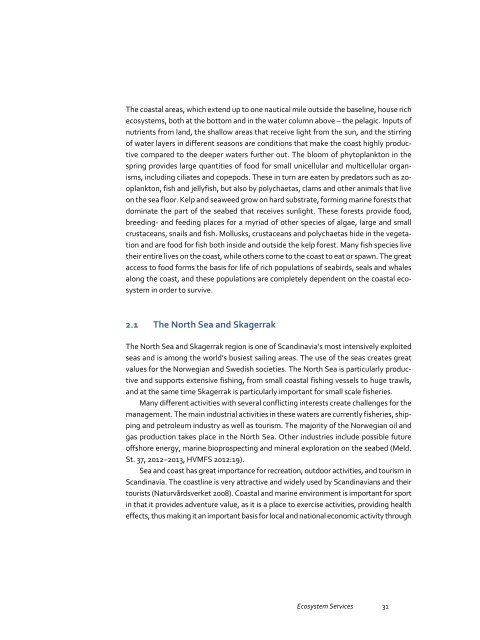Ecosystem Services
FULLTEXT01
FULLTEXT01
Create successful ePaper yourself
Turn your PDF publications into a flip-book with our unique Google optimized e-Paper software.
The coastal areas, which extend up to one nautical mile outside the baseline, house rich<br />
ecosystems, both at the bottom and in the water column above – the pelagic. Inputs of<br />
nutrients from land, the shallow areas that receive light from the sun, and the stirring<br />
of water layers in different seasons are conditions that make the coast highly productive<br />
compared to the deeper waters further out. The bloom of phytoplankton in the<br />
spring provides large quantities of food for small unicellular and multicellular organisms,<br />
including ciliates and copepods. These in turn are eaten by predators such as zooplankton,<br />
fish and jellyfish, but also by polychaetas, clams and other animals that live<br />
on the sea floor. Kelp and seaweed grow on hard substrate, forming marine forests that<br />
dominate the part of the seabed that receives sunlight. These forests provide food,<br />
breeding- and feeding places for a myriad of other species of algae, large and small<br />
crustaceans, snails and fish. Mollusks, crustaceans and polychaetas hide in the vegetation<br />
and are food for fish both inside and outside the kelp forest. Many fish species live<br />
their entire lives on the coast, while others come to the coast to eat or spawn. The great<br />
access to food forms the basis for life of rich populations of seabirds, seals and whales<br />
along the coast, and these populations are completely dependent on the coastal ecosystem<br />
in order to survive.<br />
2.1 The North Sea and Skagerrak<br />
The North Sea and Skagerrak region is one of Scandinavia’s most intensively exploited<br />
seas and is among the world’s busiest sailing areas. The use of the seas creates great<br />
values for the Norwegian and Swedish societies. The North Sea is particularly productive<br />
and supports extensive fishing, from small coastal fishing vessels to huge trawls,<br />
and at the same time Skagerrak is particularly important for small scale fisheries.<br />
Many different activities with several conflicting interests create challenges for the<br />
management. The main industrial activities in these waters are currently fisheries, shipping<br />
and petroleum industry as well as tourism. The majority of the Norwegian oil and<br />
gas production takes place in the North Sea. Other industries include possible future<br />
offshore energy, marine bioprospecting and mineral exploration on the seabed (Meld.<br />
St. 37, 2012–2013, HVMFS 2012:19).<br />
Sea and coast has great importance for recreation, outdoor activities, and tourism in<br />
Scandinavia. The coastline is very attractive and widely used by Scandinavians and their<br />
tourists (Naturvårdsverket 2008). Coastal and marine environment is important for sport<br />
in that it provides adventure value, as it is a place to exercise activities, providing health<br />
effects, thus making it an important basis for local and national economic activity through<br />
<strong>Ecosystem</strong> <strong>Services</strong> 31


